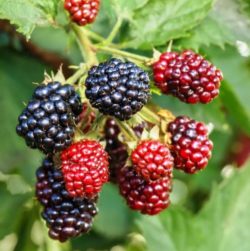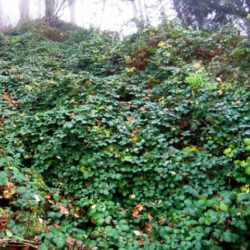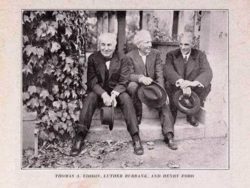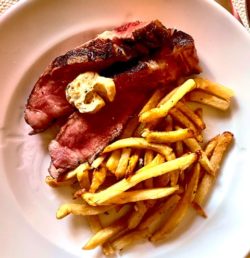Read Time: 5 Minutes Subscribe & Share
A Curious Introduction
 Last week’s post on blackberries pulled up an intriguing story about Luther Burbank, a name I remember vaguely from plant and seed catalogues that were regularly sent to my mother. She loved zinnias and Shasta daisies for her backyard garden, and whether she knew it or not, she was in debt to Luther Burbank. He was the genius who made zinnias the perfect flower for August gardens, and he crossbred several types of daisies to create the Shasta, which he named after Mount Shasta in the Cascade Mountain Range in California, since the petals had the color of pure snow. Apparently, the Shasta is the most widely grown daisy in the world. And Luther also introduced the Himalayan Blackberry to the Northwest, which while bountiful in harvests is also a plague.
Last week’s post on blackberries pulled up an intriguing story about Luther Burbank, a name I remember vaguely from plant and seed catalogues that were regularly sent to my mother. She loved zinnias and Shasta daisies for her backyard garden, and whether she knew it or not, she was in debt to Luther Burbank. He was the genius who made zinnias the perfect flower for August gardens, and he crossbred several types of daisies to create the Shasta, which he named after Mount Shasta in the Cascade Mountain Range in California, since the petals had the color of pure snow. Apparently, the Shasta is the most widely grown daisy in the world. And Luther also introduced the Himalayan Blackberry to the Northwest, which while bountiful in harvests is also a plague.
An Armenian From India
A story written by Ann Dornfeld for NPR outlines the dramatic changes wrought by industrialization, the cross-country penetration of the railroad, and the introduction of the lightbulb and the Model T. With these converging influences, a new middle class emerged in the US, centered around industrial hubs, with a commensurate desire for access to fruits and vegetables. Luther Burbank had only a high school education, but had inherited a passion for gardening from his mother. He took the profits from his hybrid potato (now named Burbank) and bought a small farm in Santa Rosa, California. He crossbred endlessly to produce fruits and vegetables that could not only withstand transcontinental shipping but also succeed in the new middle class’s smaller urban gardens. As with his effort to create a spineless
introduction of the lightbulb and the Model T. With these converging influences, a new middle class emerged in the US, centered around industrial hubs, with a commensurate desire for access to fruits and vegetables. Luther Burbank had only a high school education, but had inherited a passion for gardening from his mother. He took the profits from his hybrid potato (now named Burbank) and bought a small farm in Santa Rosa, California. He crossbred endlessly to produce fruits and vegetables that could not only withstand transcontinental shipping but also succeed in the new middle class’s smaller urban gardens. As with his effort to create a spineless  cactus for cattle forage, Luther Burbank wanted to create a thornless blackberry. He traded packets of seeds with collectors across the globe and was sent a packet of blackberry seeds from a collector in India. The berry was sensational in flavor and size – and was originally grown in Armenia. He tinkered and gave it the name of Himalaya Giant. It went into his gardening circular with the proviso that it was perfect for gardens in mild climates. Puget Sound and the surrounding areas fit the bill.
cactus for cattle forage, Luther Burbank wanted to create a thornless blackberry. He traded packets of seeds with collectors across the globe and was sent a packet of blackberry seeds from a collector in India. The berry was sensational in flavor and size – and was originally grown in Armenia. He tinkered and gave it the name of Himalaya Giant. It went into his gardening circular with the proviso that it was perfect for gardens in mild climates. Puget Sound and the surrounding areas fit the bill.
Today, according to a noxious weed expert in Washington State, this particular blackberry grows everywhere, dry or wet soil, forests and fields, crowding out any native plant in its way. And the seeds, spread by birds, can lie underground for years before germinating and, as with any creeper, wherever its cane touches the ground, a new plant is born.
Crowning Creations, Theories & Frites
Luther Burbank had a genius for developing plants and produce that the public craved (think Freestone peach, plumcot, nectarine, and of course the Russet Burbank potato.) Others were more forgettable, such as his cross between the potato and tomato – the pomato. I should also mention his genius in creating seductive mail order catalogues and even developing specialized mailing lists. From Burbank’s over 800 new strains of vegetables, flowers and fruits, the Russet Burbank is the most widely grown potato around the world. He developed it as a solution to the Irish Potato famine, in which the potatoes died from Late Blight not only in Ireland, but across Europe as well. Ironically, he could not patent this marvelous hybrid , as patents on tubers were not allowed in the US.
I look at this photo of Luther Burbank, Thomas Edison and Henry Ford, and think that they were perhaps a bit like Bill Gates, Steve Jobs and and Mark Zuckerberg , who changed our lives in the 21st century. Like these modern titans, they too were flawed in their obsession with their genius. In Burbank’s case, he became convinced that, like his plants, human characteristics could be bred and shaped by altered environments. So it was not surprising that he joined the Eugenics movement in the US and even wrote a book titled The Training Of The Human Plant. Regrettably, he ignored the scientific treatises of Mendel and theorized about human selective breeding.
, who changed our lives in the 21st century. Like these modern titans, they too were flawed in their obsession with their genius. In Burbank’s case, he became convinced that, like his plants, human characteristics could be bred and shaped by altered environments. So it was not surprising that he joined the Eugenics movement in the US and even wrote a book titled The Training Of The Human Plant. Regrettably, he ignored the scientific treatises of Mendel and theorized about human selective breeding.
That said, I still think that my favorite potato for making frites will remain the Russet Burbank. I sort of follow the rules of Daniel Boulud for prepping them. I must confess that my favorite frying fat is beef tallow (mixed sometimes with bacon grease or duck fat).
 I peel the the potatoes, slice them on a mandoline and soak them preferably overnight, but at least several hours. You can drain and rinse again to remove more starch if you have time. I dry them thoroughly in a salad spinner or dish towel. I heat my fryer with my choice of fats to about 325F and cook the potatoes just until they form a slight crust – around three to six minutes, depending on the potato. Then I lay them out on a tray and refrigerate them if they are not going to have the second frying for a few hours. It is important, however, to bring them to room temperature before the final frying. Room temperature fries will not lower the frying temperature too much, and your fries will have a crispier exterior.
I peel the the potatoes, slice them on a mandoline and soak them preferably overnight, but at least several hours. You can drain and rinse again to remove more starch if you have time. I dry them thoroughly in a salad spinner or dish towel. I heat my fryer with my choice of fats to about 325F and cook the potatoes just until they form a slight crust – around three to six minutes, depending on the potato. Then I lay them out on a tray and refrigerate them if they are not going to have the second frying for a few hours. It is important, however, to bring them to room temperature before the final frying. Room temperature fries will not lower the frying temperature too much, and your fries will have a crispier exterior.
For the second round of frying, I prefer getting the frying fat up to 375F. It usually drops to 360F as you fry the potatoes. My Thermapen is once again my best friend here. The batches should turn golden after three to four minutes. Have your basket lined with a napkin, dish towel or paper towels ready to serve to your very happy diners. You can use fleur de sel or Maldon salt for a final sprinkle. I love the additional garnish from The Lost Kitchen Cookbook, which is a teaspoon of olive oil, mixed with a large minced garlic clove, a teaspoon of fresh thyme and 2 teaspoons of dried Herbes de Provence. And then sprinkle liberally with Maldon salt – I use it so frequently that I have a large tub on hand. She adds lavender flowers, which I liked, but this was nixed by another person in this house, so I have removed the offending buds in future editions. Right before serving, toss the fries in this mixture along with the salt of your choice and rush the basket to the table.

Kitchen Detail shares under the radar recipes, explores the art of cooking, the stories behind food, and the tools that bring it all together, while uncovering the social, political, and environmental truths that shape our culinary world.




Comments are closed here.
Follow this link to create a Kitchen Detail account so that you can leave comments!